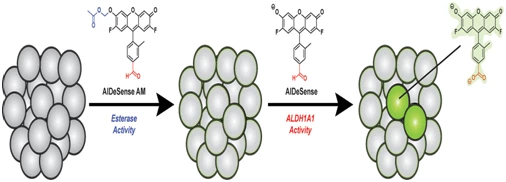Research and development of a molecular probe to identify cancer stem cells

Research and development of a molecular probe to identify cancer stem cells

Copyright © iCell Bioscience Inc, Shanghai 2018-2019
After treatment of a primary tumor, cancer stem cells may still lurk in the body, prepare for transfer to other parts of the body and cause cancer to recur in a more aggressive and resistant form.
In a new study, researchers from the University of Illinois at Urbana-Champaign developed a molecular probe to identify these elusive cancer stem cells and illuminate them so that they are not only in vitro cell culture but also Ability to identify, track and study them in the natural environment and the body.

The researchers described the effectiveness of using such molecular probes to identify cancer stem cells in in vitro cultures of various human cancer cell lines and in living mice. This is the first time that they have been observed in the complex environment in which cancer stem cells exist not just in vitro cell cultures or artificial tumor microenvironments.
Commercial reagents can be used to label cancer stem cells, but their use is limited. Some reagents cannot distinguish between live and dead cells, and other reagents may incorrectly bind to the wrong target cells. As one of the most popular commercial reagents, antibodies that bind to markers on the cell surface are cell type specific, but their larger size prevents them from entering the confined spaces that cancer stem cells typically hide. All of these agents are designed for in vitro cell culture or artificial tumor environments, but both cell culture and artificial tumor environments lack the complexity of the entire body.
In contrast, this new molecular probe, called AlDeSense, is a small molecule that is associated with one of the cancer cells' properties associated with the nature of stemness, acetaldehyde dehydrogenase 1A1 (ALDH1A1). --Combine. Only when this molecular probe reacts with ALDH1A1, it is activated, releasing a fluorescent signal. Cancer stem cells produce high concentrations of ALDH1A1.
In a series of experiments, the team found that this enzyme appears to be a dry marker in many cancer types, suggesting that AlDeSense may be widely used in clinical imaging. Of course, with the differentiation of cancer stem cells, this marker will disappear.
These researchers confirmed that AlDeSense is compatible with two major cellular technologies - flow cytometry and confocal imaging. Cancer stem cells are then searched for and tracked from tissues excised from mice undergoing biopsy and live mice with metastatic tumors.
The ability to detect and track cancer stem cells and their stem cell status in vivo allows these researchers to track the spread of cancer stem cells injected into tumors in mice, which can help answer some of the basic questions about cancer stem cell behavior.
Prior to this study, no one knew what would happen between the injection of cancer stem cells and the removal of the tumor. There are many models that hypothesize how cancer stem cells differentiate and grow, but the relevant experimental data is limited. Through this study, it was observed that this dryness was maintained in the cancer stem cell population, even after they were metastatic.
Researchers are using AlDeSense to track whether cancer stem cell populations in tumors can predict the prognosis of dogs with lymphoma. It is also committed to giving this molecular probe other functions, such as the ability to selectively kill cancer stem cells.
Inhibitions or drugs that kill cancer stem cells by targeting this enzyme. Since molecular probes interact with only one target, they can be used to find drugs that inhibit this enzyme and validate them in cell cultures and in vivo animals.
 Loading ....
Loading ....
